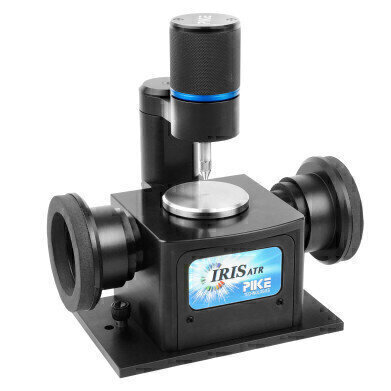-
 Figure 1. PIKE Technologies IRIS’ diamond ATR
Figure 1. PIKE Technologies IRIS’ diamond ATR -
 and cellulose propionate co-polymer..jpg) Figure 2. ATR spectra of cellulose (upper) and cellulose propionate co-polymer.
Figure 2. ATR spectra of cellulose (upper) and cellulose propionate co-polymer.
Mass Spectrometry & Spectroscopy
Copolymer Identification by ATR/FT-IR Spectroscopy
Jul 03 2019
Introduction
Polymers are ubiquitous in the food, medical, and scientific industries. The ability to identify different polymers for QC/QA is a critical step required in many applications. Attenuated Total Reflection (ATR) is a popular sampling method for FT-IR analysis used to chemically identify or distinguish between polymer samples. Here we use the IRIS monolithic diamond ATR to analyse solid cellulose and cellulose propionate copolymer samples.
Experimental Methods
Polymer samples were obtained from Scientific Polymer Products Inc. Within the Polymer Sample Kit, pure cellulose and cellulose propionate copolymer samples correspond to Cat# 661 and Cat# 321, respectively. ATR background spectra were collected without any sample present. Pure cellulose and cellulose propionate copolymer transmittance spectra were collected under the same conditions using the IRIS monolithic diamond ATR accessory (Figure 1). All spectra were collected on a commercial FTIR spectrometer. Scans were acquired over 30 seconds at a resolution of 4 cm-1.
Results
The primary vibrational bands of pure cellulose are highlighted in Figure 2 by the vertical gray-lines. These bands are associated with the free –OH stretch (3335 cm-1), C–H stretch (2900 cm-1), and C–O primary-alcohol stretch (1025 cm-1).1 These vibrational bands are also present in cellulose propionate along with three large bands originating from the propionate substituent
marked by the vertical red-lines shown in Figure 2. The two higher frequency propionate bands are associated with the C–H stretch (2940 cm-1), C=O carbonyl stretch (1745 cm-1). At lower frequencies, the presence of a polarization-dependent set of bands show up corresponding to the perpendicular and parallel oriented C–C axial stretch occurring at 884 cm-1 and 806 cm-1, respectively.2
Conclusions
The IRIS monolithic diamond is an excellent ATR accessory for a wide range of samples including powders, gels, liquids, solids, and more. Specifically, IRIS’ QA/QC abilities have been shown by distinguishing cellulose from cellulose propionate copolymer. Spectral bands were identified for each polymer.
To learn more about The IRIS Diamond ATR, click here.
Visit PIKE Technologies
References
1. Garside, P., Wyeth, P. Studies in Conservation, 48(4), 269-275 (2003)
2. Nobukawa, S., et al. Polymer Journal, 47(4), 294-301 (2015)
Digital Edition
ILM 49.5 July
July 2024
Chromatography Articles - Understanding PFAS: Analysis and Implications Mass Spectrometry & Spectroscopy Articles - MS detection of Alzheimer’s blood-based biomarkers LIMS - Essent...
View all digital editions
Events
Jul 28 2024 San Diego, CA USA
Jul 30 2024 Jakarta, Indonesia
Jul 31 2024 Chengdu, China
ACS National Meeting - Fall 2024
Aug 18 2024 Denver, CO, USA
Aug 25 2024 Copenhagen, Denmark


.jpg)
24_06.jpg)













